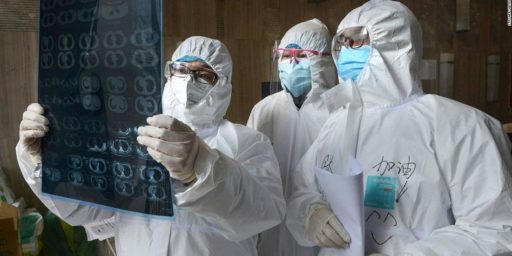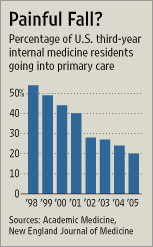Official Cause of Death Wrong at Least One Third of Time
We rely on death certificates for epidemiology studies. But they're incredibly unreliable.
Wonkblog‘s Sarah Kliff points to a Center for Disease Control survey finding that a third of US death certificates list the wrong cause of death.
But the survey doesn’t really tell us that. Here’s how the report itself (“Survey of New York City Resident Physicians on Cause-of-Death Reporting, 2010“) describes the study:
The death certificate is a public document issued by a government body that declares the date, location, and cause of a person’s death (1). Local municipalities determine the form of the death certificate. Death certificates are important legal documents and public health tools. Death certificates are used by public health researchers for identification of the leading causes of death, for surveillance of disease patterns, and for identification of disease outbreaks (1,2). Death certificate data are also used to determine public health funding and clinical research priorities. Because the number of autopsies performed is decreasing, death certificates have become an even more important source of data on the causes of death of Americans (3-5).
Several researchers have studied patient medical charts for errors in cause-of-death reporting, and several have demonstrated inaccurate cause-of-death reporting among residents (3,6,7). One study found that only 56.9% of attending physicians, 56.0% of resident physicians, and 55.7% of medical students matched experts for the correct cause of death in clinical case studies, indicating a need for instruction at all levels of practice (3). Another study found that 45% of resident respondents incorrectly identified a cardiovascular event as the primary cause of death. This study also found that more experience in death certificate completion resulted in fewer errors in cardiac diagnosis (6). The Framingham Heart Study and other studies have indicated that coronary artery disease is overestimated on death certificates as a cause of death in the general population by 24% and by as much as 2 times more in older patients. The extent to which such overestimation affects the quality of death certificate information and national mortality statistics is not known (4,8,9,10).
In the United States, approximately one-third of all deaths occur in hospitals (11). The death registration process involves physicians and hospital staff, funeral directors, the medical examiner’s office, and the health department bureau of vital statistics. The physician’s role in this process is to describe the chain of medical events or conditions leading to death and to certify the underlying cause of death. Hospital administrative staff helps to prepare the certificate and ensures it is completed in a timely manner. In most teaching hospitals, resident physicians are responsible for the completion of death certificates (12). The objective of this study was to examine the experiences and opinions of New York City physician residents on the accuracy of completing death certificates. A secondary objective was to identify sources of inaccuracy, limitations of the current system, and potential areas of improvement.
So, obviously, the findings may be skewed if New York City is radically different from the rest of the country in some way. Perhaps less obviously, the methodology applies only to the “approximately one-third of all deaths [that] occur in hospitals.”
The findings:
Only one-third of respondents (33.3%) believed the current system accurately documents correct cause of death (Table 2). Among the 3 major specialties surveyed, emergency medicine residents had the most negative opinion of the system’s accuracy: only 27.3% believed the system is accurate, compared with 32.9% of internal medicine respondents and 41.0% of general surgery respondents. Almost half of all respondents (48.6%) and 58.4% of high-volume respondents (Table 3) reported they had identified a cause of death on a death certificate that did not represent the true cause of death. More than half of the residents (54.0%) reported they were unable to list what they felt to be the correct cause of death after guidance from the admitting department in their hospital (Table 2). Only 20.8% of respondents were aware they could report “probable,” “presumed,” or “undetermined” as a cause of a death, and only 2.9% of respondents indicated they had ever updated a death certificate when new information (eg, microbiology culture results) became available. Only 39.8% of respondents reported receiving any training by their residency program in death certificate completion, and only 21.5% of respondents reported being directed to the New York City’s Board of Health mandatory training module on death certificate completion.
Of all respondents, 70.0% believed they were forced to identify an alternate cause of death when the patient died of septic shock (compared with 83.5% of high-volume respondents), and 34.2% believed they were forced to identify an alternate cause when the patient died of acute respiratory distress syndrome (compared with 44.3% of high-volume respondents). Overall, high-volume respondents had a more negative opinion of the accuracy of cause-of-death reporting than all respondents; whereas 33.3% of all respondents believed the system is accurate, only 22.7% of high-volume residents believed so (Table 3). Among respondents who reported identifying an alternate cause of death, 64.6% of respondents reported cardiovascular disease as the most frequent diagnosis assigned, 19.5% reported pneumonia, and 12.4% reported cancer.
Most residents identified system-based issues as cause of failure. Of respondents who reported recording an inaccurate cause of death, 76.8% of all respondents and 84.6% of high-volume respondents believed that the death certificate system simply would not accept the true cause of death (Table 3). The next most common belief among those who reported identifying an alternate cause was that personnel in the hospital admitting department instructed them to do so; 40.5% all respondents and 49.3% of high-volume respondents believed this. Also among those reporting an alternate cause, 30.7% of all respondents and 34.6% of high-volume respondents indicated that the medical examiner instructed them to do so. Survey respondents identified transfer of care between residents as a problem; of respondents who reported identifying an alternate cause of death, 20.4% of respondents gave the reason, “I didn’t know the patient/it was on my ‘signout’ from another team,” and 17.8% of respondents reported, “I just put something down that would be easily accepted.”
The survey indicated several possible areas of improvement. Of respondents who did not believe the system was accurate, 56.7% of all respondents and 62.1% of high-volume respondents believed changing the system to allow certain conditions as acceptable causes of death is the problem area offering the “biggest room for improvement.” Respondents also suggested improving education: of respondents who did not believe the system was accurate, 26.1% cited lack of education on how to fill out death certificates properly.
So, what we know, then, is that the people who assign the cause of death to those people who die in hospitals in New York City have a relatively low level of confidence in the system.
Logically, then, I would extrapolate that the one third number grossly underestimates the problem.
First, New York City hospitals likely have substantially better-than-average attending physicians. It’s a very desirable place to live for those with the ability to afford the high cost of living and highly educated professionals tend to be drawn to such places. Additionally, New York City is home to or within close proximity to some of the best teaching hospitals on the planet.
Second, attending physicians in New York City hospitals likely have an inflated sense of their own prowess, making them likely to over-estimate the percentage of the time they’re getting the cause of death right.
Third, and most importantly, we’re far more likely to know what killed people who died in hospitals under the supervision of medical professionals than those who died elsewhere.
My wife died at home. Because she was young and hadn’t been diagnosed with a life-threatening illness, the medical examiner’s office performed an autopsy. But the medical examiner’s office is grossly understaffed and basically have two goals: ruling out foul play (or, conversely, documenting evidence of homicide) and ruling out epidemic disease. Having accomplished those goals, there’s not much incentive to dig deeper.
In my wife’s case, the autopsy did not turn up anything definitive. There were no signs of a heart attack, brain aneurysm, or any other thing that would trigger a sudden death in a healthy 41-year-old. She had a somewhat enlarged heart, likely a byproduct of having given birth five months earlier, but there were no indications that was a cause of death. The lack of an obvious cause of death triggered an automatic toxicology test, which dragged out the issuance of an official death certificate (and thus, the ability to collect life insurance, among other thing) for weeks. The toxicology report, too, found nothing out of the ordinary.
She’d gone to the emergency room the day before complaining of a severe cough, which was untreatable with over-the-counter medicines because she was nursing. They diagnosed her with strep throat, prescribed an antibiotic, and released her. Given the lack of anything better to list, that’s what they put down as the cause of death. Even though there was no sign of sepsis or any other indication that she’d died from an infection. They had to put something on the death certificate and the ER diagnosis provided a convenient fallback.
The problem is that she didn’t actually have strep throat. The lab results, which came back after her death and which we looked at doing our due diligence afterwards, found she didn’t actually have strep infection. Indeed, the tests didn’t find anything.
This is in Fairfax County, Virginia, a relatively affluent area. In a situation where an autopsy and toxicology were performed. It stands to reason that, in areas where the medical examiner’s office is less-well-resourced and in cases where an expensive autopsy isn’t called for, it’s quite likely that they just take a half-educated guess and let it go at that.







This has been known for decades. The ER physician who signs off on many death certificates does not want to take the time to fill out all of the paperwork. It is just easy to write that a DOA at the emergency room died of a heart attack and move on. They are not going to fill out the paperwork to list the underlying causes.
There is also the problem that autopsies are not really done any more. There is no method to pay for them and no one wants to wait for the results.
Heart failure is involved in all deaths so that’s always a good catch-all.
There are other reasons death certificates might not be reliable guides for studies. My dad’s great-uncle’s death certificate says that he died of tuberculosis. The family was quite aware that he’d died of venereal disease but they had a certain amount of clout so it didn’t get publicized.
It sounds like listing one cause of death, and using that cause for epidemelogical studies, are at cross-purposes. Take the “ARDS” mentioned above:
If we want to know the prevelence of pneumonia, we want pneumonia on the certificate. [or we want a different reporting system, with some sort of list of contributing causes]
@john personna:
For the last century most death certificates in the U. S. have included both primary and contributing causes of death as well as how they were diagnosed.
Another problem is that the farther in time you go back, the more likely the cause of death is to be a judgment call. Fifty years ago a diagnosis of heart failure wasn’t uncommon when the actual cause of death might have been, say, undiagnosed cancer of the pancreas. That would both overstate the prevalence of heart disease and understate that of cancer of the pancreas.
@Dave Schuler:
OK, but still this report, and the pointed question in the survey about inclusion of ARDS, seems to say that the system is confused about how to handle “final syndromes” as opposed to “causes.”
@Dave Schuler:
Generally agreed, but a poor example. If the patient comes in bright yellow, heart attack is a lousy diagnosis..
As mentioned, there’s several problems, one of which is the localized death certificates. I assume somebody has suggested standardizing death certificates across the United States, right? Or can’t we do that because it’s not enumerated in the Constitution as a power granted to the federal government?
There was a somewhat similar story last week about an insurance company funded study of cell phone usage during accidents. They found that evidence of cell phone usage was disregarded in the reports; that when the driver admitted cell phone usage during the accident, it wasn’t getting coded into the national system, etc. This meant Tennessee reported 93 fatal accidents with cell phones contributing during the same period that New York reported one.
There’s probably two sets of cases that are going to be problematical:
1) cases where the deceased suffered from a bunch of things that could have brought on death, and 2) cases where there’s nothing and the victim drops dead (Mr. Joyner’s wife would fall in this category.
In both cases, figuring out what actually caused the death may be difficult if not impossible. I’d be worried more about case (2) above rather than case (1). In case (1), it’s probably just a question of which ghastly symptom killed the individual first, and if he didn’t die of X, he would soon after die of Y. Putting down the variety of afflictions and not picking an actual cause of death may be the most useful info.)
In case (2), you’d think that we would really, really want to know what is going on…and if we don’t know, it would probably be best to put down “don’t know” rather than picking something random that sends the epidemologists off down a rabbit hole.
Just my two cents.
@James Joyner
I’m sorry you have to deal with that continued uncertainty. I can’t think of anything more vexing than not getting an answer as to why, for a number of personal reasons.
@Ben Wolf: Thanks. It’s been harder on her mother, who thinks everything has to have a reason, than on me, who thinks life often just sucks for no damned reason. For me, the only real reason knowing would be useful is to know whether the girls are at particular risk for something that could kill them young. But there’s no real evidence for that.
Using “old age” on a death certificate has been prohibited since the early 1950’s, even though in many cases that’s the real cause.